Improvement of the Interaction Model Aimed to Reduce the Negative Effects of Cybersickness in VR Rehab Applications
Abstract
:1. Introduction
1.1. Virtual Reality and History of Cybersickness
1.2. Characteristics of Virtual Environments
1.2.1. Immersion
1.2.2. Presence
1.2.3. Vection
1.3. Types of Negative Symptoms and Effects
1.4. Cybersickness as Obstacle in Using VR for Rehabilitation of Patients
2. The Process of Creating and Testing the Impact of a Virtual Environment on a User
2.1. Setting of Test Parameters
2.2. Testing and Collecting Results
2.3. Creating Virtual Environment
- -
- the modeling of the VR environment;
- -
- model testing and filling in questionnaires by users;
- -
- analytical-deductive and statistical methods.
3. Evaluation of the Obtained Results
4. Discussion
5. Conclusions
Author Contributions
Funding
Institutional Review Board Statement
Informed Consent Statement
Data Availability Statement
Conflicts of Interest
References
- Kiryu, T.; So, R.H. Sensation of presence and cybersickness in applications of virtual reality for advanced rehabilitation. J. Neuro Eng. Rehabil. 2007, 4, 34. [Google Scholar] [CrossRef] [PubMed] [Green Version]
- Standen, P.; Brown, D. Virtual Reality in the Rehabilitation of People with Intellectual Disabilities: Review. Cyberpsychology & Behavior: The Impact of the Internet, Multimedia and Virtual Reality on Behavior and Society. 2005. Available online: https://www.researchgate.net/publication/7771483_Virtual_Reality_in_the_Rehabilitation_of_People_with_Intellectual_Disabilities_Review (accessed on 14 February 2020).
- Wilson, P.N.; Foreman, N.; Stanton, D. Virtual reality, disability and rehabilitation. Disabil. Rehabil. 1997, 19, 213–220. [Google Scholar] [CrossRef] [PubMed]
- Snider, L.; Majnemer, A.; Darsaklis, V. Virtual reality as a therapeutic modality for children with cerebral palsy. Dev. Neurorehabilit. 2010, 13, 120–128. [Google Scholar] [CrossRef] [PubMed]
- Bell, M.D.; Weinstein, A. Simulated job interview skill training for people with psychiatric disability: Feasibility and tolerability of virtual reality training. Schizophr. Bull. 2011, 37 (Suppl. 2), S91–S97. [Google Scholar] [CrossRef] [Green Version]
- Lotan, M.; Yalon-Chamovitz, S.; Weiss, P.L. Virtual reality as means to improve physical fitness of individuals at a severe level of intellectual and developmental disability. Res. Dev. Disabil. 2010, 31, 869–874. [Google Scholar] [CrossRef]
- McComas, J.; Pivik, J.; Laflamme, M. Current uses of Virtual Reality for Children with Disabilities. Stud. Health Technol. Inform. 1998, 161–169. Available online: http://levelcentre.com/wp-content/uploads/2016/12/McComas.doc.pdf (accessed on 11 February 2020).
- Krysta, K.; Krzystanek, M.; Cubała, W.J.; Wiglusz, M.S.; Jakuszkowiak-Wojten, K.; Gałuszko-Węgielnik, M.; Czarnowska-Cubała, M.; Szarmach, J.; Włodarczyk, A.; Janas-Kozik, M. Telepsychiatry and Virtual Reality and the Treatment of Patients with Intellectual and Developmental Disabilities. Psychiatr. Danub. 2017, 29, 656–659. [Google Scholar]
- Nabors, L.; Monnin, J.; Jimenez, S. A Scoping Review of Studies on Virtual Reality for Individuals with Intellectual Disabilities. Adv. Neurodev. Disord. 2020, 4, 344–356. [Google Scholar] [CrossRef]
- Panerai, S.; Catania, V.; Rundo, F.; Ferri, R. Remote Home-Based Virtual Training of Functional Living Skills for Adolescents and Young Adults with Intellectual Disability: Feasibility and Preliminary Results. Front. Psychol. 2018, 9, 1730. [Google Scholar] [CrossRef]
- Foreman, N.; Stirk, J.; Jayawardena, S.; Johnson, D.A.; Morris, R.G.; Potter, J.; Pugnetti, L.; Mendozzi, L. Commentary on Rose, F.D., Brooks, B.M., & Rizzo, A.A., virtual reality in brain damage rehabilitation: Review. Cyber Psychol. Behav. 2005, 8, 241–262. [Google Scholar] [CrossRef]
- William, B.; Stone, I. Psychometric Evaluation of the Simulator Sickness Questionnaire as a Measure of Cybersickness. Ph.D. Thesis, Iowa State University, Ames, IA, USA, 2017. [Google Scholar]
- Harrington, C.M.; Kavanagh, D.O.; Quinlan, J.F.; Ryan, D.; Dicker, P.; O’Keeffe, D.; Traynor, O.; Tierney, S. Development and Evaluation of a Trauma Decision-making Simulator in Oculus Virtual Reality. Am. J. Surg. 2018, 215, 42–47. [Google Scholar] [CrossRef]
- Aldaba, C.N.; White, P.J.; Byagowi, A.; Moussavi, Z. Virtual reality body motion induced navigational controllers and their effects on simulator sickness and pathfinding. In Proceedings of the 39th Annual International Conference of the IEEE Engineering in Medicine and Biology Society (EMBC), Jeju Island, Korea, 11–15 July 2017; Available online: https://ieeexplore.ieee.org/document/8037776 (accessed on 14 February 2020).
- Fernandes, S.A.; Feiner, S.K. Combating VR Sickness through Subtle Dynamic Field-Of-View Modification. 2016. Available online: http://www.cs.columbia.edu/2016/combating-vr-sickness/images/combating-vr-sickness.pdf (accessed on 12 February 2020).
- Tiiro, A. Effect of Visual Realism on Cybersickness in Virtual Reality. 2018. Available online: https://www.semanticscholar.org/paper/Effect-of-visual-realism-on-cybersickness-in-Tiiro/a4173881295298565c398418d39a8f8cf175b007 (accessed on 14 February 2020).
- Kemeny, A.; George, P.; Mérienne, F.; Colombet, F. New VR Navigation Techniques to Reduce Cybersickness. Eng. Real. Virtual Real. 2017, 6, 48–53. [Google Scholar]
- Hale, K.S.; Stanney, K.M. Handbook of Virtual Environments, 2nd ed.; CRC Press: Boca Raton, FL, USA, 2014; Available online: https://www.taylorfrancis.com/books/9780429098710 (accessed on 10 February 2020).
- Johnson, D.M. Introduction to and Review of Simulator Sickness Research; U.S. Army Research Institute for the Behavioral and Social Sciences: Indianapolis, IN, USA, 2005; Available online: https://pdfs.semanticscholar.org/9ed8/8e0e36ac99ce49fa3386d632acb27ca7a8dd.pdf (accessed on 14 February 2020).
- Steurer, J. Defining Virtual Reality: Dimensions Determining Telepresence. J. Commun. 1992, 42, 73–93. Available online: https://doi.org/10.1111/j.1460-2466.1992.tb00812.x (accessed on 20 February 2020). [CrossRef]
- Lowood, H.E. Virtual Reality. In Encyclopædia Britannica; Encyclopædia Britannica, Inc.: Chicago, IL, USA, 2020; Available online: https://www.britannica.com/technology/virtual-reality (accessed on 20 October 2020).
- Sanchez-Vives, M.V.; Slater, M. From presence to consciousness through virtual reality. Nat. Rev. Neurosci. 2005, 6, 332–339. [Google Scholar] [CrossRef] [PubMed]
- Huppert, D.; Benson, J.; Brandt, T. A Historical View of Motion Sickness—A Plague at Sea and on Land, Also with Military Impact. Front. Neurol. 2017, 4, 114. [Google Scholar] [CrossRef] [PubMed] [Green Version]
- Reason, J.; Brandt, T. Motion Sickness; Academic Press: London, UK, 1975; Available online: https://www.worldcat.org/title/motion-sickness/oclc/1014355654?referer=di&ht=edition (accessed on 14 February 2020).
- Kennedy, R.; Lane, N.; Lilienthal, M.; Berbaum, K.; Hettinger, L. Profile Analysis of Simulator Sickness Symptoms: Application to Virtual Environment Systems. Presence Virtual Augment. Real. 1992, 1, 295–301. [Google Scholar] [CrossRef]
- Stanney, K.; Kennedy, R.; Drexler, J. Cybersickness is not simulator sickness. SAGE J. 1997, 41, 1138–1142. [Google Scholar] [CrossRef]
- Slater, M. A Note on Presence Terminology. 2003. Available online: https://www.semanticscholar.org/paper/A-note-on-presence-terminology-Slater/ed277f9067a0b6aadd90c055d31aecc8ab92aa2f (accessed on 18 February 2020).
- Ott, M.; Freina, L. A Literature Review on Immersive Virtual Reality in Education: State of the Art and Perspectives. 2015. Available online: https://www.itd.cnr.it/download/eLSE%202015%20Freina%20Ott%20Paper.pdf (accessed on 14 February 2020).
- Bowman, D.A.; McMahan, R.P. Virtual Reality: How Much Immersion Is Enough? Computer 2007, 40, 36–43. [Google Scholar] [CrossRef]
- Lombard, M.; Biocca, F.; Freeman, J.; Jsselsteijn, W.; Schaevitz, R.J. Immersed in Media: Telepresence Theory, Measurement & Technology; Springer: Berlin/Heidelberg, Germany, 2015. [Google Scholar]
- Barrett, J. Side Effects of Virtual Environments: A Review of the Literature; Department of Defence, Australian Government: Canberra, Australia, 2004; Available online: https://pdfs.semanticscholar.org/ab1b/4153e44abb4c1a1fcac5f2aaee847d30ecf3.pdf (accessed on 12 February 2020).
- Slater, M.; Wilbur, S. A Framework for Immersive Virtual Environments (FIVR): Speculations on the Role of Presence in Virtual Environments. Presence Virtual Augment. Real. 1997, 6, 603–616. [Google Scholar] [CrossRef]
- Joseph, J.; LaViola, J. A Discussion of Cybersickness in Virtual Environments. SIGCHI Bull. 2000, 32, 47–56. [Google Scholar]
- Treisman, A. Focused attention in the perception and retrieval of multidimensional stimuli. Percept. Psychophys. 1977, 22, 1–11. [Google Scholar] [CrossRef]
- Bonato, F.; Bubka, A.; Palmisano, S.; Phillip, D.; Moreno, G. Vection Change Exacerbates Simulator Sickness in Virtual Environments. Presence Virtual Augment. Real. 2008, 17, 283–292. [Google Scholar] [CrossRef]
- Vinson, N.G.; Lapointe, J.F.; Parush, A.; Roberts, S. Cybersickness induced by desktop virtual reality. In Proceedings of the Graphics Interface, Toronto, ON, Canada, 12 May 2012; pp. 69–75. Available online: https://dl.acm.org/citation.cfm?id=2305288 (accessed on 14 March 2020).
- Davis, S.; Nesbitt, K.; Nalivaiko, E. A Systematic Review of Cybersickness. In Proceedings of the IE2014: 2014 Conference on Interactive Entertainment, Newcastle, Australia, 2–3 December 2014; pp. 1–9. [Google Scholar]
- Kennedy, R.; Lane, N.; Berbaum, K.; Lilienthal, M. Simulator Sickness Questionnaire: An Enhanced Method for Quantifying Simulator Sickness. Int. J. Aviat. Psychol. 1993, 3, 203–220. [Google Scholar] [CrossRef]
- Zyda, M. From visual simulation to virtual reality to games. Computer 2005, 38. Available online: https://ieeexplore.ieee.org/document/1510565 (accessed on 12 March 2020). [CrossRef]
- García-Peñalvo, F.J.; Conde, M.Á.; Del Pozo, A. A Mobile Personal Learning Environment Approach. In Virtual, Augmented and Mixed Reality. Systems and Applications. Lecture Notes in Computer Science; Shumaker, R., Ed.; VAMR 2013; Springer: Berlin/Heidelberg, Germany, 2013; p. 8022. [Google Scholar] [CrossRef]
- Veličković, P.; Minović, M.; Krsmanović Veličković, S. Tehnologije mrežnog prenosa zvuka. Časopis Inf. Tehnol. Multimedijalne Sist. Info M 2016, 58, 1451–4397. [Google Scholar]
- Berntsen, K.; Colomo-Palacios, R.; Herranz, E. Virtual reality and its uses: A systematic literature review. In Proceedings of the Fourth International Conference on Technological Ecosystems for Enhancing Multiculturality, Salamanca, Spain, 2–4 November 2016. [Google Scholar] [CrossRef]
- Clifton, J.; Palmisano, S. Effects of steering locomotion and teleporting on cybersickness and presence in HMD-based virtual reality. Virtual Real. 2020, 24, 453–468. [Google Scholar] [CrossRef]
- IrisVR. Navigation Controls in Prospect. 2020. Available online: https://help.irisvr.com/hc/en-us/articles/115015330667-Navigation-Controls-in-Prospect (accessed on 14 February 2020).
- Kennedy, R.S.; Frank, L.H. Review of Motion Sickness with Special Reference to Simulator Sickness; Canyon Reprear Group: Sanger, CA, USA, 1985; Available online: https://apps.dtic.mil/dtic/tr/fulltext/u2/a155975.pdf (accessed on 20 February 2020).
- Likert, R. A technique for the measurement of attitudes. In Archives of Psychology; The Science Press: New York, NY, USA, 1932; Available online: https://psycnet.apa.org/record/1933-01885-001 (accessed on 14 February 2020).
- Croarkin, C.; Tobias, P. (Eds.) Tukey’s Method. In ENIST/SEMATECH e-Handbook of Statistical Methods; NIST: Washington, DC, USA, 2012. Available online: https://www.itl.nist.gov/div898/handbook/prc/section4/prc471.htm (accessed on 11 February 2020).
- Johnson, D.M. Simulator Sickness Research Summary; RTO-TR-HFM-121-Part-II; U.S. Army Research Institute for the Behavioral and Social Science: Ft. Rucker, AL, USA, 2005; Available online: https://apps.dtic.mil/dtic/tr/fulltext/u2/a474304.pdf (accessed on 14 February 2020).
- Bockelman, P.; Lingum, D. Factors of Cybersickness. In Communications in Computer and Information Science, Proceedings of the HCI International 2017—Posters’ Extended Abstracts, HCI 2017, Vancouver, BC, Canada, 9–14 July 2017; Stephanidis, C., Ed.; Springer: Orlando, FL, USA, 2017; Volume 714, pp. 3–8. [Google Scholar] [CrossRef]
- Manresa-Yee, C.; Morrison, A.; Guasp, J.J.; Roig-Maimó, M.F. Multi-sensory Environmental Stimulation for Users with Multiple Disabilities. Intell. Syst. Ref. Libr. 2017, 119, 165–182. [Google Scholar]
- Veličković, P.; Krsmanović Veličković, S.; Milovanović, M. Theories of origin problems using virtual reality systems. Časopis Inf. Tehnol. Multimedijalne Sist. Info M 2019, 70. Available online: https://147.91.134.42/index.php/infom/article/view/2387 (accessed on 11 February 2020).
- Agudo-Peregrina, Á.F.; Hernández-García, Á.; Iglesias-Pradas, S. Predicting academic performance with learning analytics in virtual learning environments: A comparative study of three interaction classifications. In Proceedings of the International Symposium on Computers in Education (SIIE 2012), Andorra La Vella, Andorra, 29–31 October 2012; pp. 1–6. Available online: https://www.computer.org/csdl/pds/api/csdl/proceedings/download-article/12OmNA0vnOo/pdf (accessed on 12 February 2020).
- Veličković, P.; Krsmanović Veličković, S.; Vuksanović, M. Factors that affecting on efficiency of human work in virtual environments. J. SVET Rada 2019, 16, 725–736. [Google Scholar]
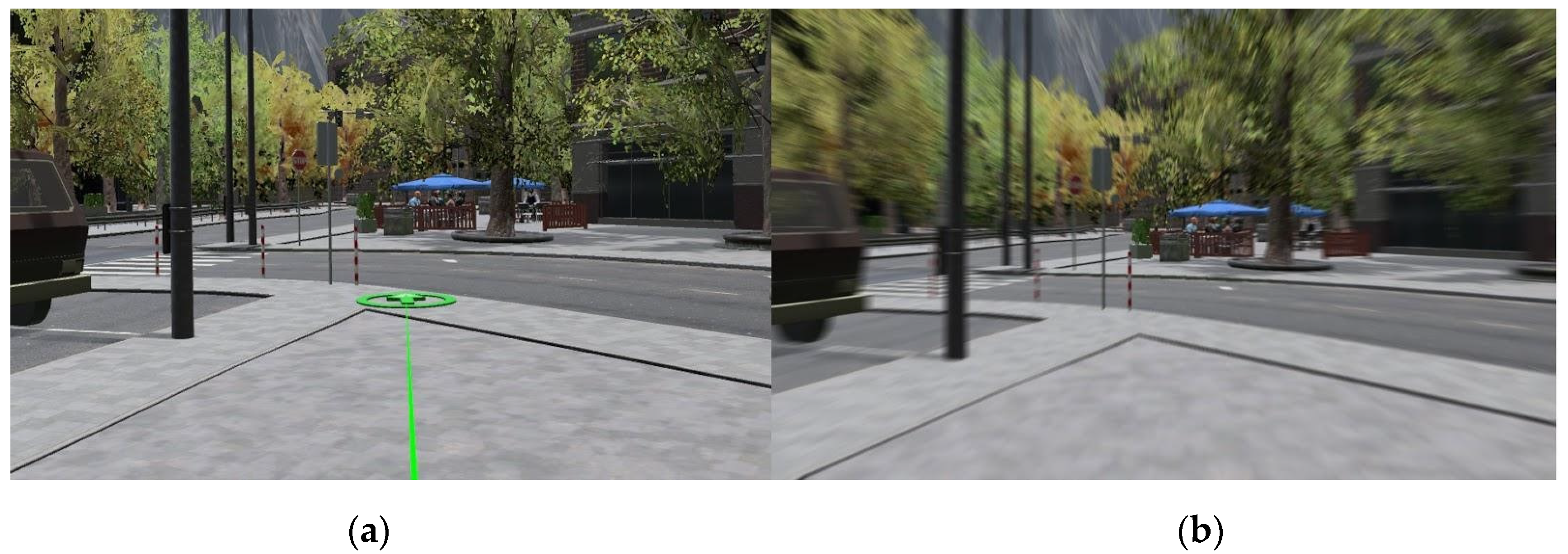
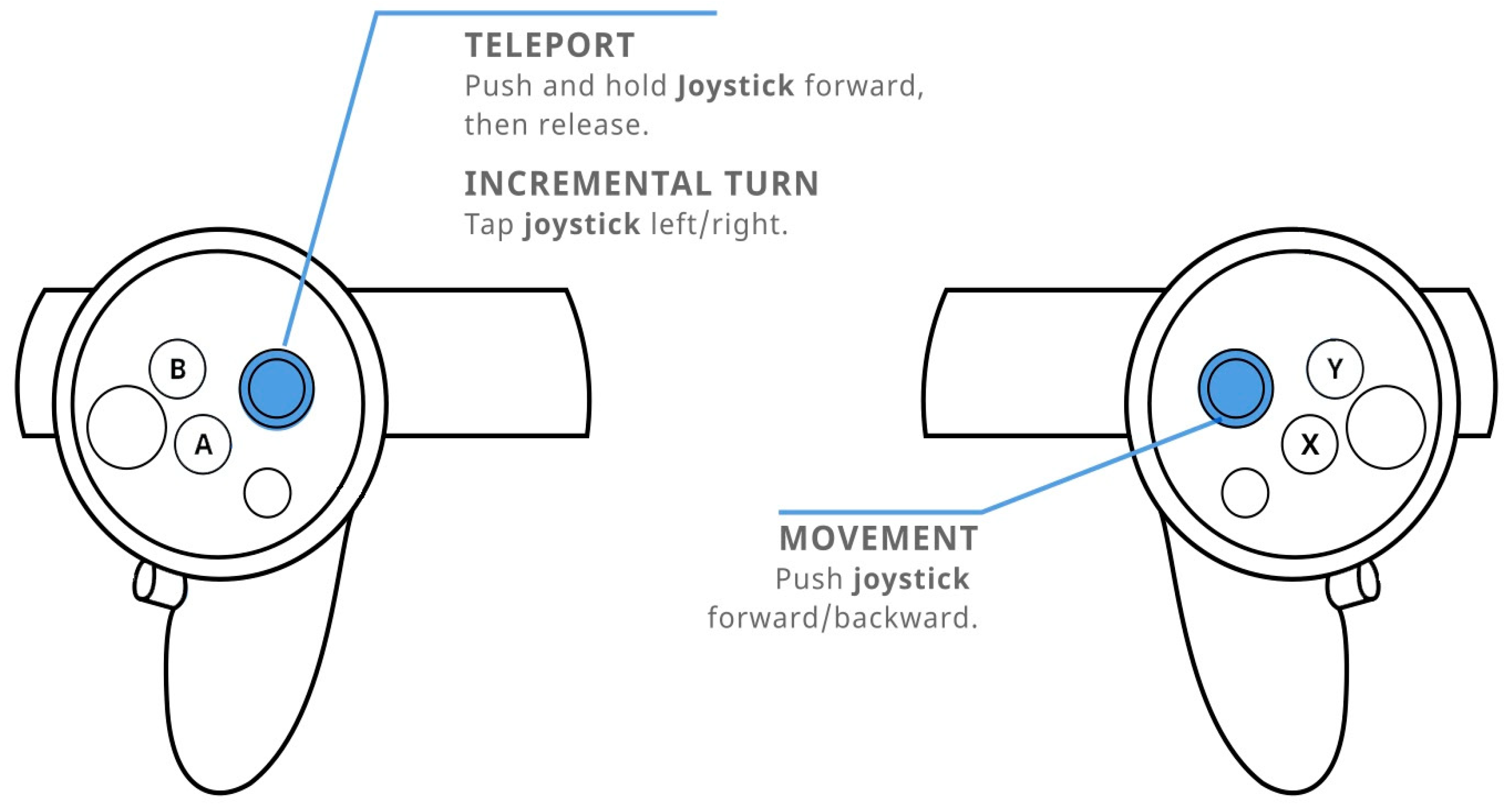
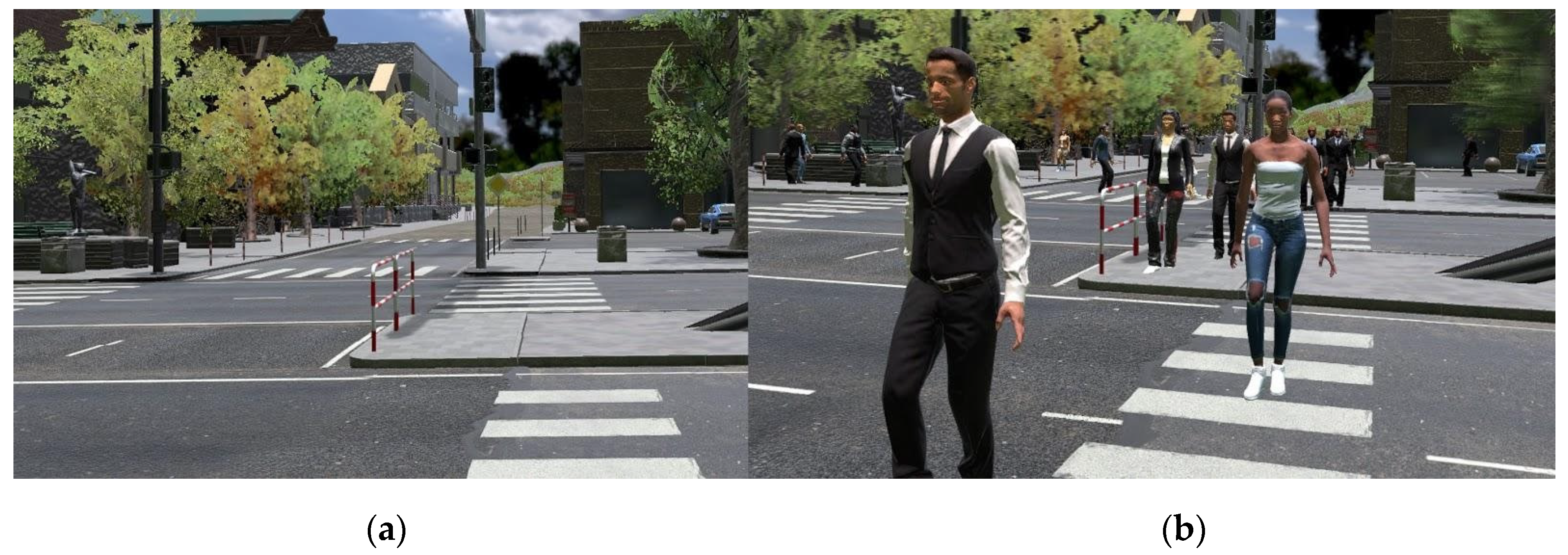





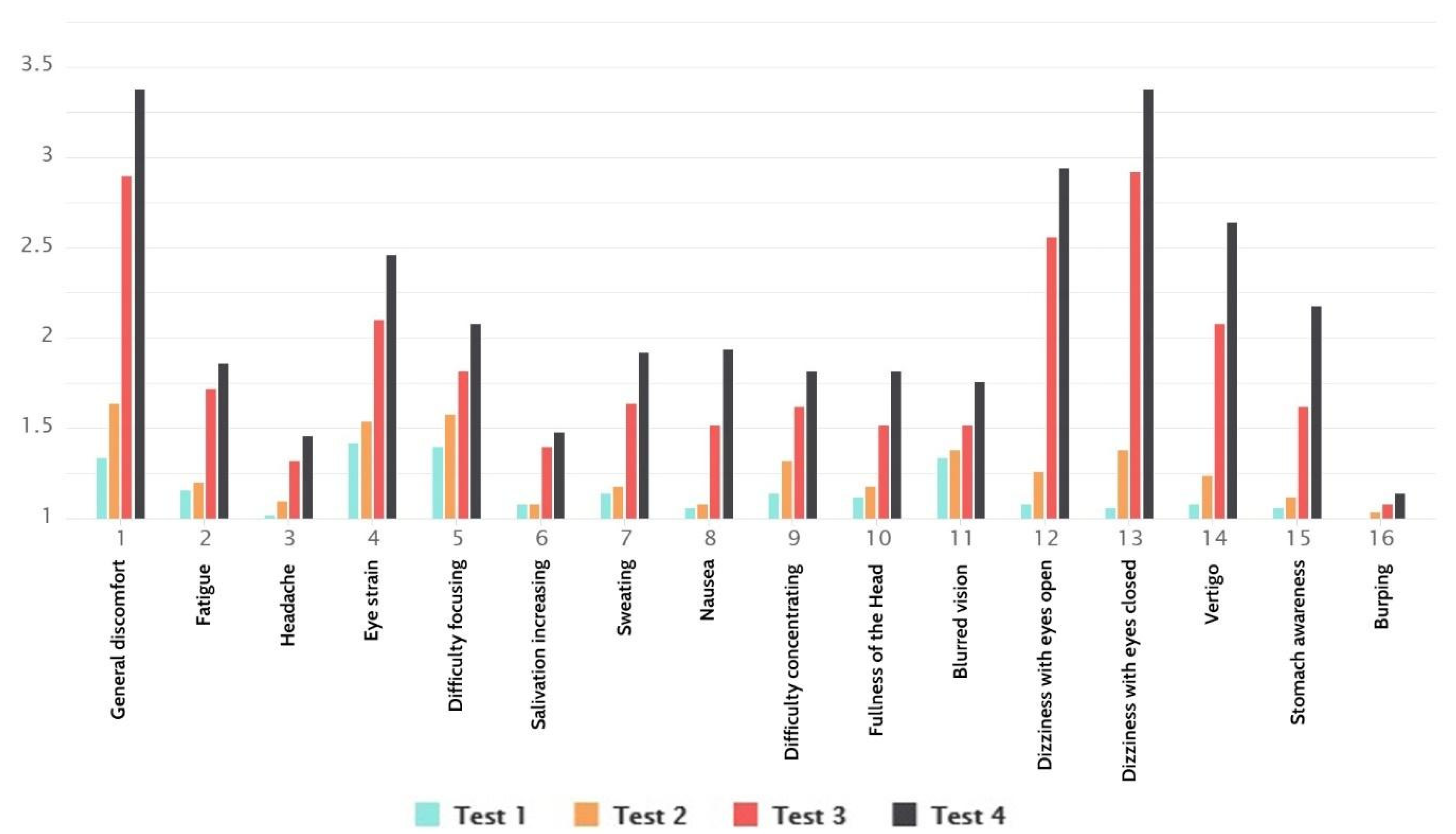
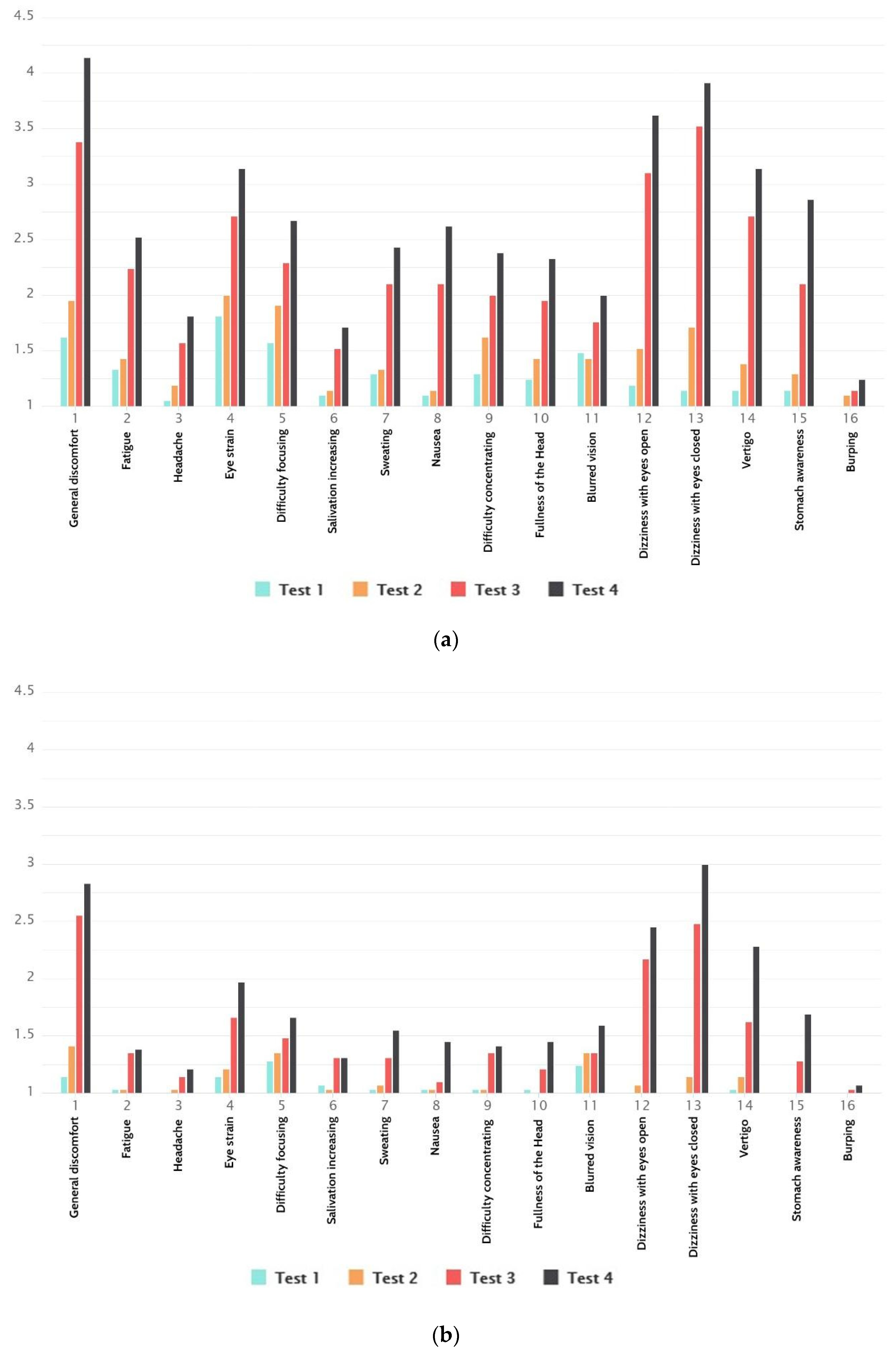
| Nausea | Oculomotor Symptoms | Disorientation |
|---|---|---|
| Stomach discomfort Increased salivation Burping | Tingling in the eyes Loss of concentration Blurred vision A headache | Dizziness Loss of balance |
| General Discomfort | Difficulty Concentrating |
|---|---|
| Fatigue | Fullness of the Head |
| Headache | Blurred vision |
| Eye strain | Dizziness with eyes open |
| Difficulty focusing | Dizziness with eyes closed |
| Salivation increasing | Vertigo |
| Sweating | Stomach awareness |
| Nausea | Burping |
| Symptom | Test 1 Mean (SD) | Test 2 Mean (SD) | Test 3 Mean (SD) | Test 4 Mean (SD) |
|---|---|---|---|---|
| 1. General discomfort | 1.34 (0.52) | 1.64 (0.60) | 2.90 (0.91) | 3.38 (1.18) |
| 2. Fatigue | 1.16 (0.42) | 1.20 (0.45) | 1.72 (0.83) | 1.86 (1.05) |
| 3. Headache | 1.02 (0.14) | 1.10 (0.36) | 1.32 (0.84) | 1.46 (0.86) |
| 4. Eye strain | 1.42 (0.57) | 1.54 (0.68) | 2.10 (0.93) | 2.46 (1.13) |
| 5. Difficulty focusing | 1.40 (0.53) | 1.58 (0.64) | 1.82 (0.98) | 2.08 (0.93) |
| 6. Salivation increasing | 1.08 (0.27) | 1.08 (0.34) | 1.40 (0.76) | 1.48 (0.93) |
| 7. Sweating | 1.14 (0.49) | 1.18 (0.44) | 1.64 (0.96) | 1.92 (1.31) |
| 8. Nausea | 1.06 (0.31) | 1.08 (0.34) | 1.52 (0.84) | 1.94 (1.11) |
| 9. Difficulty concentrating | 1.14 (0.40) | 1.32 (0.55) | 1.62 (0.85) | 1.82 (0.92) |
| 10. Fullness of the head | 1.12 (0.38) | 1.18 (0.48) | 1.52 (0.76) | 1.82(1.04) |
| 11. Blurred vision | 1.34 (0.74) | 1.38 (0.75) | 1.52 (0.86) | 1.76 (1.08) |
| 12. Dizziness with eyes open | 1.08 (0.34) | 1.26 (0.56) | 2.56 (0.95) | 2.94 (1.25) |
| 13. Dizziness with eyes closed | 1.06 (0.31) | 1.38 (0.70) | 2.92 (0.90) | 3.38 (1.07) |
| 14. Vertigo | 1.08 (0.34) | 1.24 (0.51) | 2.08 (1.00) | 2.64 (1.21) |
| 15. Stomach awareness | 1.06 (0.31) | 1.12 (0.38) | 1.62 (0.83) | 2.18 (1.08) |
| 16. Burping | 1 (0) | 1.04 (0.28) | 1.08 (0.44) | 1.14 (0.49) |
| The cumulative result | 1.13 (0.12) | 1.31 (0.25) | 1.90 (0.60) | 2.25 (0.78) |
| Source | Sum of Squares SS | Degrees of Freedom ν | Mean Square MS | F Statistic | p-Value |
|---|---|---|---|---|---|
| test | 10.4545 | 3 | 3.4848 | 17.8131 | 2.1989 × 10−8 |
| error | 11.7379 | 60 | 0.1956 | ||
| total | 22.1924 | 63 |
| Test | Tukey HSD Q Statistic | Tukey HSD p-Value | Tukey HSD Inference |
|---|---|---|---|
| 1 vs. 2 | 1.0287 | 0.8766316 | insignificant |
| 1 vs. 3 | 6.1270 | 0.0010053 | p < 0.01 |
| 1 vs. 4 | 8.9079 | 0.0010053 | p < 0.01 |
| 2 vs. 3 | 5.0983 | 0.0034737 | p < 0.01 |
| 2 vs. 4 | 7.8792 | 0.0010053 | p < 0.01 |
| 3 vs. 4 | 2.7809 | 0.2122966 | insignificant |
| Source | Sum of Squares SS | Degrees of Freedom ν | Mean Square MS | F Statistic | p-Value |
|---|---|---|---|---|---|
| test | 3.4672 | 3 | 1.1557 | 5.2448 | 0.0063 |
| error | 5.2886 | 24 | 0.2204 | ||
| total | 8.7558 | 27 |
| Test | Tukey HSD Q Statistic | Tukey HSD p-Value | Tukey HSD Inference |
|---|---|---|---|
| 1 vs 2 | 0.5153 | 0.8999947 | insignificant |
| 1 vs 3 | 3.1885 | 0.1373060 | insignificant |
| 1 vs 4 | 4.8632 | 0.0107602 | p < 0.05 |
| 2 vs 3 | 2.6732 | 0.2587072 | insignificant |
| 2 vs 4 | 4.3479 | 0.0249842 | p < 0.05 |
| 3 vs 4 | 1.6748 | 0.6288279 | insignificant |
| Source | Sum of Squares SS | Degrees of Freedom ν | Mean Square MS | F Statistic | p-Value |
|---|---|---|---|---|---|
| test | 3.3489 | 3 | 1.1163 | 6.0356 | 0.0033 |
| error | 4.4389 | 24 | 0.1850 | ||
| total | 7.7878 | 27 |
| Test | Tukey HSD Q Statistic | Tukey HSD p-Value | Tukey HSD Inference |
|---|---|---|---|
| 1 vs 2 | 0.8261 | 0.8999947 | insignificant |
| 1 vs 3 | 3.6736 | 0.0701518 | insignificant |
| 1 vs 4 | 5.2732 | 0.0053753 | p < 0.01 |
| 2 vs 3 | 2.8475 | 0.2111234 | insignificant |
| 2 vs 4 | 4.4470 | 0.0213151 | p < 0.05 |
| 3 vs 4 | 1.5995 | 0.6580020 | insignificant |
| Source | Sum of Squares SS | Degrees of Freedom ν | Mean Square MS | F Statistic | p-Value |
|---|---|---|---|---|---|
| test | 6.8357 | 3 | 2.2786 | 12.0602 | 5.1824 × 10−5 |
| error | 4.5344 | 24 | 0.1889 | ||
| total | 11.3701 | 27 |
| Test | Tukey HSD Q Statistic | Tukey HSD p-Value | Tukey HSD Inference |
|---|---|---|---|
| 1 vs. 2 | 0.8348 | 0.8999947 | insignificant |
| 1 vs. 3 | 5.0434 | 0.0079470 | p < 0.01 |
| 1 vs. 4 | 7.3216 | 0.0010053 | p < 0.01 |
| 2 vs. 3 | 4.2086 | 0.0311513 | p < 0.05 |
| 2 vs. 4 | 6.4869 | 0.0010053 | p < 0.01 |
| 3 vs. 4 | 2.2782 | 0.3927065 | insignificant |
Publisher’s Note: MDPI stays neutral with regard to jurisdictional claims in published maps and institutional affiliations. |
© 2021 by the authors. Licensee MDPI, Basel, Switzerland. This article is an open access article distributed under the terms and conditions of the Creative Commons Attribution (CC BY) license (http://creativecommons.org/licenses/by/4.0/).
Share and Cite
Veličković, P.; Milovanović, M. Improvement of the Interaction Model Aimed to Reduce the Negative Effects of Cybersickness in VR Rehab Applications. Sensors 2021, 21, 321. https://doi.org/10.3390/s21020321
Veličković P, Milovanović M. Improvement of the Interaction Model Aimed to Reduce the Negative Effects of Cybersickness in VR Rehab Applications. Sensors. 2021; 21(2):321. https://doi.org/10.3390/s21020321
Chicago/Turabian StyleVeličković, Predrag, and Miloš Milovanović. 2021. "Improvement of the Interaction Model Aimed to Reduce the Negative Effects of Cybersickness in VR Rehab Applications" Sensors 21, no. 2: 321. https://doi.org/10.3390/s21020321
APA StyleVeličković, P., & Milovanović, M. (2021). Improvement of the Interaction Model Aimed to Reduce the Negative Effects of Cybersickness in VR Rehab Applications. Sensors, 21(2), 321. https://doi.org/10.3390/s21020321




